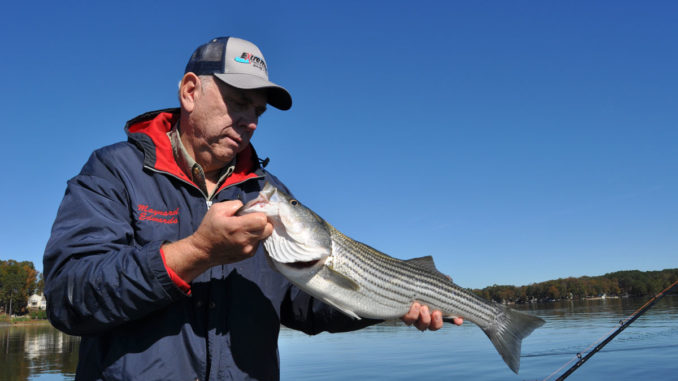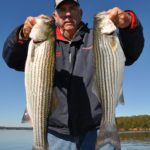
Lexington guide has found that bass lures will produce plenty of High Rock stripers in January.
Being a self-effacing guy, Maynard Edwards smiled when he recalled how once upon a January he stumbled across a new way to catch striped bass at High Rock Lake.
The retired school teacher, who has guided on Yadkin system lakes for 21 years, didn’t take credit for having a brainstorm. He laughed when he described it as a combination of luck and paying attention that allowed him to have one of his best days ever catching stripers, and he’s used the technique with good success ever since.
“I was fishing in a bass boat with a couple of guys, and we were in Flat Swamp Creek,” he said. “A warm front had come through a few days earlier, and the surface temperature had warmed up some, so we thought some baitfish and largemouths might be around some drop-offs.”
They were casting shallow-running crankbaits and suspending jerkbaits that tracked about 6 feet deep, keying on rocky bluffs. They’d caught a few largemouths when Edwards hooked a fish that changed the way he approached winter striper fishing at High Rock.
“The bass were nothing to brag on,” said Edwards. “Then I got a backlash. Sometimes it’s tough to throw those light crankbaits, especially if there’s some wind.
“I was standing there, trying to get the tangle out of my line, and I finally got (it) worked out, put the line between my fingers and was slowly cranking the reel with my fingers keeping pretty good tension on the line so I could re-spool it tight around the reel.
“I’d got in most of the slack, but I was still cranking slowly. I could see my crankbait just kind of slowly waggling under the surface. The water was very clear. Then this long dark shape came up from underneath.
There wasn’t any sudden jolt to the rod, Edwards said. All of a sudden the line just bogged down. Then the fish just slowly bent his 7-foot bass rod double and swam off.
“I went ‘Whoa-oh,’” he said, “and it was on.”
His fishing partners were intrigued by what was happening.
“One of them said, ‘If that’s a bass, you got the lake record,’ ” Edwards said.
After about a 5-minute tussle, he pumped and cranked a 12-pound striped bass to the surface and netted it.
“My buddies said, ‘What happened there?’ ” he said. “I said, ‘I dunno.’”
But of course he did know — the barely-moving lure had attracted the attention of a striper.
“The next cast, I threw the lure right up against the base of the rock wall and turned the reel’s handle a couple of times slowly, then I felt another tug, and another striper had swallowed the lure and started to move off,” Edwards said.
He landed the fish after another drag-pulling fight on 15-pound mono.
“Boy, my buddies were all over me then, wanting know what I was doing,” Edwards said, “so I told them.”
Over the next few hours, the three anglers caught a dozen stripers weighing from 12 to 20 pounds, using medium-running crankbaits from 3- to 3 ½-inches long and suspending jerkbaits that dove 5 to 10 feet deep.
“I remember a Rattlin’ Rogue jerkbait worked really well,” he said. “We haven’t tried a small Alabama rig, but I expect that would work.”
Nowadays, whenever he can take a small guide party in his bass boat, he’s headed to Flat Swamp with crankbaits and jerkbaits tied on. Many times, however, if he’s got a large party, he has to avoid Flat Swamp because he can’t get his pontoon boat under the railroad trestle at the mouth of the creek. He winds up slow-trolling the main lake and mouth of Abbotts Creek, dragging bucktails and Alabama rigs 15 to 25 feet deep when he marks bait and stripers on his depth finder.
“Trolling’s OK,” he said. “You can catch fish, and everyone’s happy. But for me, it’s a lot more fun fishing for stripers in creeks, casting plugs at the shoreline like bass fishing, and playing them with light tackle.”
Several factors play into this type of fishing, which probably would work at any of the Yadkin lakes: High Rock, Tuckertown, Badin and Tillery — all deep enough to have healthy numbers of stripers.
“First, you’ve got to have an area in a creek with deep water that comes up quickly near shallow water because stripers will be near a deep channel if they’re in a creek,” Edwards said. “Then you need relatively clear water. You don’t have to have gin-clear; it can be a little stained, but you don’t want muddy water.”
Stripers, aka “rockfish” apparently have an affinity for rocky shelves and bottoms, he said.
“The places we find the most stripers in creeks during winter have what I call rock rubble that drops off into deep water,” Edwards said. “I think over the years, pieces on those rock walls have broken off, fell into the water and basically made a rock rubble slope, all the way to the bottom. I think baitfish like to be around those rocks, too.”
On that first January day, the water temperature was in the mid- to low-40s.
“Stripers like cool water,” Edwards said, “but I like a couple of days in the 50s before I go fishing (so) the surface temperature goes up a little. I think that’s what pulls baitfish into the creek.”
When main-lake water is frigid, the creeks also are protected from north and northeast winds. With two or three consecutive sunny days, sunlight warms them, pulling in baitfish.
“I think stripers either know or watch where baitfish schools go in winter and concentrate at the mouths of deeper creeks, waiting on the baitfish to move into the creeks,” he said. “They they follow them towards the backs, but not all the way. I’d say they go into the first 20-percent of creeks with deep channels. The sun shining on those rocky shorelines also warms the rocks, which attracts baitfish, and stripers follow them.”
Edwards believes stripers follow the shoreline like a roadway. If the creeks get too cold, baitfish move back into the main lake and the stripers follow them.
“You also have to remember that cooler water slows down the movements of everything, from baitfish to stripers,” said Edwards, who remembered seeing small threadfin shad swimming parallel to the rocky bluffs that first January day — one reason they figured largemouth might bite.
“But the stripers were waiting for them, too,” he said. “I’d say they were suspended in 15 to 20 feet of water in a channel that’s 35 feet deep.
“Your boat’s often sitting in that channel, but a medium cast of 30 yards will put your lure right up against the bank, then you work the lure really slow down the side. The stripers hang down there, looking up for one of those small baitfish to fall or go deep. But you don’t work the lure fast; they don’t want that. That was the most important thing I learned when I had the backlash and was reeling in my line: taking my time, making the lure wobble slowly.”
Edwards said January isn’t the only month anglers can catch stripers using bass lures.
“It starts in December when it gets cold and continues right on through March,” he said. “You also can tell where stripers are in the deep creeks when you see lots of (gulls) and clouds of baitfish on your depth finder.”
One of the most important pieces of equipment he likes to have is a “reel with a great drag.”
He prefers 7-foot medium-action baitcasting rods mated to older Lew’s reels spooled with 10- to 16-pound line.
“My Lew’s BB1 reels are probably 30 years old, but I love the drags,” he said. “The sad thing is they’re out of production, and you can’t get parts for them. They’re perfect for throwing a lure about 30 yards, and they’ll handle big stripers. But any good modern baitcaster with a smooth drag will work fine.”
“Abbotts Creek is another place that’ll have stripers near the mouth in winter,” Edwards said. “It’s not nearly as deep the farther up that creek, so stripers don’t go so far up that creek. And you can easily go underneath the NC 8 and railroad bridge at Southmont and into Abbotts.”
High Rock Lake gets plenty of fishing pressure, especially for largemouth, crappie and striped bass. Stripers can’t naturally reproduce by swimming up the Yadkin River because their fertilized eggs don’t have enough distance to float and mature into striper fry. To keep anglers happy, the N.C. Wildlife Resources Commission annually stocks about 30,000 striper fry and fingerlings into the lake’s 15,180 acres.
DESTINATION INFORMATION
HOW TO GET THERE — High Rock Lake is on the Yadkin River south of Lexington and east of Salisbury. NC 8 is the prime route to access popular boat ramps on the eastern side of the lake at Abbotts Creek, Buddle Creek and Flat Swamp Creek. I-85 to Salisbury and Bringles Ferry Road will offer access at Second Creek across the road from Tamarac Marina.
WHEN TO GO — January through March.
BEST TECHNIQUES — Medium-action baitcasting tackle, with rods around 6-foot-10 to 7-foot, with 10- to 16-pound mono spooled on the reels. Medium-diving crankbaits and jerkbaits are preferred lures.
FISHING INFO/GUIDES — Maynard Edwards, Yadkin Lakes Guide Service, 336-247-1287. See also Guides and Charters in Classifieds.
ACCOMMODATIONS — Lexington Chamber of Commerce, 336-248-5929, www.lexingtonchamber.com; Rowan County Chamber of Commerce, www.visitsalisburync.com; Denton Chamber of Commerce, www.denton-chamber.org.
MAPS — Fishing Hot Spots, 800-500-MAPS, www.fishinghotspots.com.









